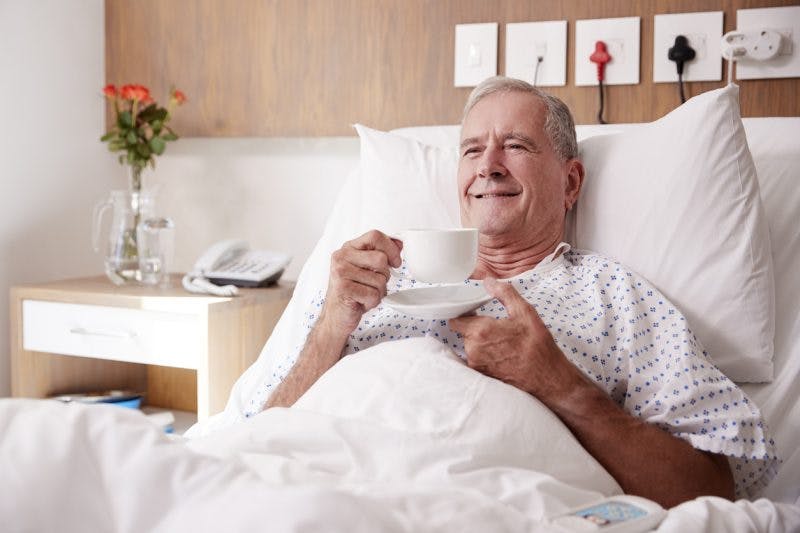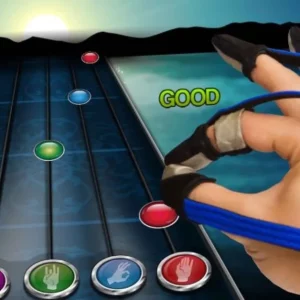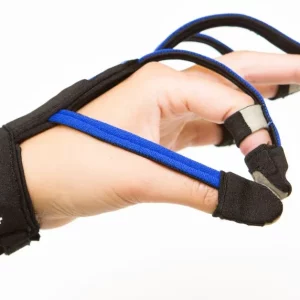Nearly 80% of stroke survivors may experience dysphagia, a condition characterized by difficulty swallowing. In approximately 40% of survivors, post-stroke dysphagia becomes a persistent condition, lasting up to 6 months or longer. Swallowing exercises for stroke patients may help individuals overcome dysphagia and regain the ability to swallow safely and effectively.
Speech-language pathologists, also known as speech therapists, are considered the experts in assessing and treating dysphagia. Survivors should discuss any new swallowing exercises for stroke patients with their speech therapist as a measure of safety.
Dysphagia has many serious potential complications, such as choking or aspiration pneumonia. Therefore, it is critical for survivors to address dysphagia in a timely manner and consult with their medical team before attempting anything new at home.
This article will review the benefits of practicing swallowing exercises for stroke patients and include a list of potential exercises to try. Tips for survivors with dysphagia will also be discussed. Please use the links below to jump directly to any section.
- Benefits of swallowing exercises
- 10 of the best swallowing exercises
- Tips for survivors with dysphagia
Benefits of Swallowing Exercises
Before outlining some of the best swallowing exercises for stroke patients, it is helpful to understand how exercises can help with recovery. Following a stroke, many survivors are referred to therapy to address any effects they may be experiencing.
A significant component of many therapy programs is exercise. This is because repetitive exercises and activities are crucial for activating neuroplasticity, or the brain’s ability to rewire itself. When the brain undergoes adaptive rewiring, it is able to transfer control of affected functions to healthy areas of the brain, resulting in lasting functional improvements.
Therefore, consistently practicing swallowing exercises for stroke patients can encourage recovery by promoting adaptive changes in the brain. In addition to stimulating the brain, practicing swallowing exercises can improve oral-motor coordination and help strengthen the muscles associated with swallowing.
Repetitious practice of swallowing exercises promotes faster changes within the brain. With this in mind, in order to optimally benefit from these exercises, it is important to practice both during therapy sessions and through a home program. With permission from one’s medical team, the following swallowing exercises for stroke patients are a great place for survivors to start on their journey toward recovery.
Want 25 pages of stroke recovery exercises in a PDF? Click here to download our free Stroke Rehab Exercise ebook now (link opens a pop up for uninterrupted reading)
The Best Swallowing Exercises for Stroke Patients
While there are many different swallowing exercises, below are some of the most effective, evidence-based swallowing exercises for stroke patients. Practicing these exercises is an excellent way to promote neuroplasticity and regain the ability to swallow safely and efficiently. However, it is essential to consult with one’s speech therapist and/or medical team before trying any of these exercises as a safety precaution.
1. Tongue Stretches
Tongue function is critical for both chewing and swallowing food. Therefore, maximizing the tongue’s motion through stretching can help individuals with dysphagia improve.
Stick the tongue out as far as it can reach. Then, stretch the tongue to the left, holding for a few seconds before returning to the center. Stretch the tongue to the right next, again holding for a few seconds before returning to the middle. Repeat 10 times.
2. Tongue Forward Pushing
Strengthening the tongue can also help survivors to regain the ability to swallow safely. Start by pushing the tongue against the top of the mouth, where the front teeth connect to the palate. Press and hold for a few seconds, and release. Repeat 5 times.
3. Tongue Upward Pushing
Touch the tip of the tongue to the top of the mouth, where the teeth meet the inside of the mouth. Slide the tongue back approximately one inch, so it is against the top of the mouth. Starting from this position, push the tongue upward, holding for a few seconds before releasing. Repeat 5 times.
4. Neck Strengthener
Also known as the shaker exercise, this exercise strengthens some of the neck muscles involved in swallowing, including the suprahyoid muscles. Furthermore, it helps to open the top of the esophagus, allowing food to enter more easily.
Start by lying flat on the back, then raise the head as if trying to look at the toes. Try to keep the shoulders touching the floor or mat while doing this. Then relax the head back down. Repeat 5 times.
Consider increasing the duration of the head lifts or the number of repetitions to increase the challenge. Survivors with a tracheostomy placement should not complete this exercise.
5. Chin Tucks
Chin tuck exercises are a relatively new therapeutic swallowing exercise for stroke patients. In addition to improving dysphagia after stroke, chin tucks against resistance have been demonstrated to reduce the likelihood of aspiration (food entering the airway).
Start by placing a small, soft ball under the chin. Then, press the chin down, holding the ball between the chin and the chest for 5-10 seconds. Release, and repeat 10 times.
6. Tongue Hold Exercises
Stick out the tongue and hold it gently between the front teeth, or with the fingers if necessary. Then, practicing swallowing with the tongue in this position. Repeat 10 times. This exercise, sometimes referred to as the Masako exercise, improves the strength and movement of the muscles in the back of the throat.
7. Effortful Swallow
This exercise is one of the most functional swallowing exercises for stroke patients because it directly involves swallowing. In addition to practicing the mechanics of swallowing, this exercise can increase the strength of muscles involved.
To complete an effortful swallow, practice swallowing hard while pushing the tongue against the top of the mouth. Some survivors benefit from pretending they are swallowing a golf ball, squeezing all the muscles involved in the swallow. Repeat 10 times.
8. Pitch Gliding
Pitch gliding, also known as laryngeal elevation, is another great exercise for survivors with dysphagia to try. This exercise focuses on raising the larynx (voice box), which is an essential component of swallowing.
Begin by taking a deep breath, then saying the sound “eeee” in a low pitch. Gradually slide the voice into a high pitched “eeee”, and hold for a few seconds. Repeat 10 times.
9. Breathing Exercises
Breathing exercises are a simple, yet effective, way to address swallowing difficulties. Start by taking a slow, intentional deep breath in. Hold the air for a few seconds, then exhale and repeat. Next, practice inhaling deeply and quickly, followed by exhaling slowly and deliberately. Repeat each of these breathing exercises 5 times.
10. Straw Exercises
Speech therapists often use a technique called expiratory muscle strength training (EMST), in which survivors forcibly blow through a pressure threshold device to strengthen specific muscles involved with swallowing. While most individuals do not have an appropriate pressure threshold device at home, the principles of this intervention can be applied to more simplified exercises involving blowing through a straw.
Start with a deep inhalation, then exhale through a straw sitting in a glass of water. Blowing out through the straw provides resistance, strengthening the associated muscles.
As a precaution, do not practice any of the above exercises with food or drinks in the mouth. Additionally, survivors should always contact their medical team before starting any new swallowing exercises.
Practicing various swallowing exercises for stroke patients can help survivors target different components of swallowing. In addition to helping to improve range of motion, strength, and coordination, practicing these exercises consistently can promote adaptive changes in the brain, stimulating a fuller recovery.
Tips for Survivors with Dysphagia
Experiencing dysphagia can be challenging for stroke survivors and their loved ones. While working with a speech therapist and practicing swallowing exercises are excellent ways to improve swallowing skills, a full recovery may take some time.
Meanwhile, it may be helpful to have some tips for living with dysphagia. The following are some ideas to help survivors with dysphagia and their loved ones:
- Timing of meals. Eating with dysphagia may be very tiring for stroke survivors. Therefore, survivors may benefit from structuring their routines to include mealtimes at periods of the day when they are well-rested. Furthermore, some survivors find that eating smaller, more frequent meals helps to limit fatigue, leading to safer and more effective swallowing patterns.
- Consuming a varied diet. Since survivors with dysphagia often are recommended to only eat certain food textures, some individuals consume a very limited diet of the same few foods each day. However, a nutrient-dense diet can improve recovery outcomes. Furthermore, consuming a variety of foods can also lead to more enjoyable mealtimes. This online cookbook from the American Stroke Association includes a variety of recipes for those with dysphagia, as well as tips of how to modify each recipe to an appropriate texture.
- Taking safety precautions. One of the most important tips for living with dysphagia is to ensure survivors are able to eat safely. Due to their difficulty with swallowing, survivors with dysphagia are at a high risk of choking. Therefore, it is essential for family members and loved ones to know when and how to perform the Heimlich maneuver. If a survivor is unable to cough, talk, or breathe, they are choking. The Heimlich maneuver can help to dislodge food blocking the airway through a series of 5 back blows, followed by 5 abdominal thrusts. Taking a first aid class through the local hospital or Red Cross is the best way to accurately learn the Heimlich maneuver as a precaution.
Although many survivors with dysphagia fully recover, these tips are good to keep in mind throughout the recovery process. Survivors can also consult with their speech therapist and/or a dietician to discover better ways to cope with dysphagia.
Want 20 pages of stroke recovery tips in an illustrated PDF? Download our free ebook by clicking here (link opens a pop up for uninterrupted reading)
Understanding Dysphagia After Stroke
Consistently practicing swallowing exercises for stroke patients is an excellent way to retrain the brain and improve the ability to swallow effectively. Consulting with a speech therapist can help individuals discover which exercises are best for them, since different exercises address different components of swallowing.
During the recovery process, many survivors find it helpful to focus on timing meals appropriately and eating a wide variety of foods. Ensuring family members and loved ones are properly trained to identify and address signs of choking is also essential for the safety of survivors with dysphagia.
It is important to remember that every stroke is different, so it is crucial for survivors to work closely with a speech therapist to customize a program appropriate for their specific needs. Hopefully the exercises and tips included in this article are able to help survivors pursue a full recovery from dysphagia after stroke.










